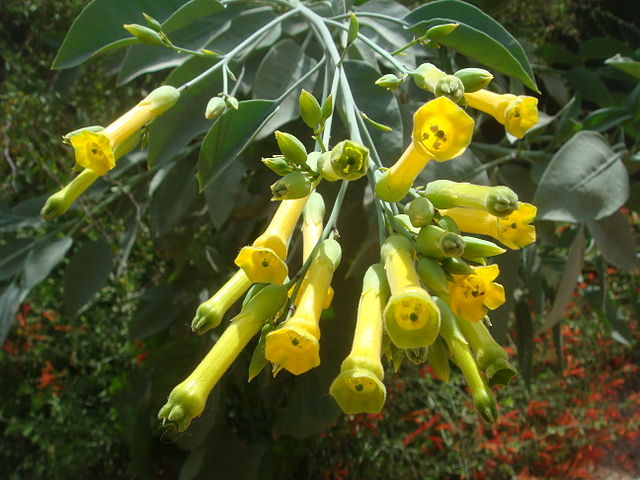
A new study shows invasive plants are adapting to new habitats and new climates at an increasing pace – and especially so in tropical environments.

A new study shows invasive plants are adapting to new habitats and new climates at an increasing pace – and especially so in tropical environments.
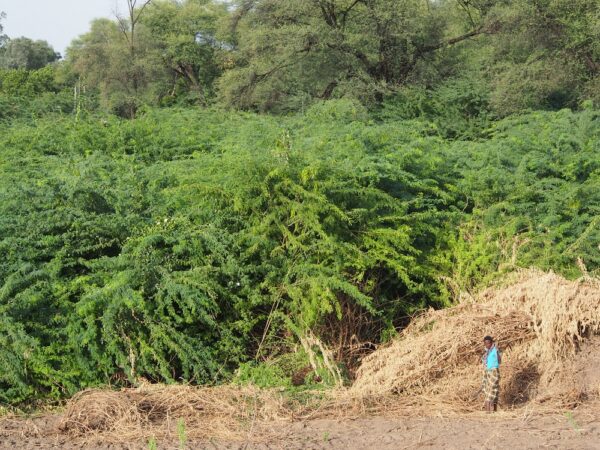
New research has revealed how an invasion of the alien evergreen tree, Prosopis juliflora seriously diminishes water resources in the Afar Region of Ethiopia, consuming enough of this already scarce resource to irrigate cotton and sugarcane generating some US$ 320 million and US$ 470 million net benefits per year.
A team of Ethiopian, South African and Swiss scientists, including lead author Dr Hailu Shiferaw, Dr Tena Alamirew, and Dr Gete Zeleke from the Water and Land Resource Centre of Addis Ababa University, Ethiopia, and Dr Sebinasi Dzikiti from Stellenbosch University, South Africa, and Dr Urs Schaffner, Head Ecosystems Management, CABI, have been assessing water use of prosopis and its impacts on catchment water budget and rural livelihoods in the dry Afar Region of Ethiopia, since 2015 as part of a long-term collaboration in the framework of the CABI-led Woody Weeds project.
Their new study, published in Scientific Reports, provides evidence that this alien tree, which has invaded both the floodplains of the Awash River and the surrounding dryland habitats, uses excessive amounts of water by consuming approximately 3.1-3.3 billion m3/yr of water throughout the year in the Afar Region.
Dr Shiferaw said, “We found that single trees of the evergreen prosopis consume between 1-36 liters of water per day, depending on stem diameter and site conditions. Prosopis trees not only use water throughout the year, but even consume more water during the dry season, when almost all native plants have shed their leaves. The high sap flow of prosopis in the drylands throughout the year may be due to exceptionally deep roots that penetrate up to 50m below the surface, where they tap into groundwater that cannot be used by native trees with shorter roots.”
In the context of climate change and an increasing frequency of drought events in dry regions of Sub-Saharan Africa, the report concludes that this invasive tree is likely to have serious consequences for sustainable livelihoods in the region unless its spread is contained and its density reduced.
Dr Urs Schaffner, senior author and Head Ecosystems Management at CABI in Switzerland, said, “Since its introduction in the Afar Region in the 1980s, prosopis has invaded 1.2 million ha of land. Thus, unless the spread of prosopis is contained and the density reduced in areas where it has become established, this invasive tree is likely to have serious consequences for sustainable livelihoods in the region. The estimated net benefits from water savings alone would strongly justify the implementation of a coordinated control programme.”
The report clearly supports findings from work undertaken in South Africa on water use by invasive tree species. Prof Brian van Wilgen from Stellenbosch University, South Africa, previous scientific advisor to the ‘Working for Water’ programme in South Africa and partner of the Woody Weeds project, said, “In South Africa, invasive alien trees are estimated to reduce surface water runoff by between 1.5 and 2.5 billion m3 per year, and this could increase substantially as the invasions continue to spread. In addition, invasive trees in drier parts of the country have substantially reduced water in groundwater aquifers on which local farmers and towns are totally reliant.”
He further explained that, “These losses have serious consequences for a country where water scarcity limits economic activity and growth. The government in South Africa has responded by creating a multi-million dollar, national-scale programme, dubbed ‘Working for Water’, to control invasive alien trees, and has also passed legislation preventing further propagation of invasive alien trees and requiring landowners to control them.”
Read the paper: Scientific Reports
Article source: CABI
Image: Prosopis juliflora. Credit: CABI.

Scientists have led the first assessment of naturalised, invasive and potentially invasive plant species present in Laikipia County, Kenya, which hosts the highest populations of endangered large mammals in the country.

Researchers have created the world’s first framework, to better guide the management of terrestrial invasive species. By using a big data approach the researchers found a way to prioritise targets in the control of invasive species.

Drifting algae in the Austral Ocean can bring invasive species to the Antarctic coasts, according to a new study. The report describes the first scientific evidence of a potentially invasive and colonial species –the marine bryozoan Membranipora membranacea- which reaches the Antarctic latitude islands in macroalgae that drift in the marine environment.

A new species of gigantic tumbleweed once predicted to go extinct is not only here to stay — it’s likely to expand its territory.
A while ago we published a blog post about the sequencing of the Bauhinia genome. Bauhinia x blakeana is the national flower of Hong Kong, so naturally this sparked our interest in the global importance of flowers as national symbols, such as the English rose. Here we list just a few of the more interesting and unusual plants that are the national symbols of countries hosting GPC member organizations.
India Indian Society for Plant Physiology
Nelumbo nucifera

The Lotus Plant (Nelumbo nucifera) is an aquatic plant in the Nelumbonaceae family, and is the national flower of India and Vietnam. Image by alterna used under Creative Commons 2.0.
The lotus plant (Nelumbo nucifera) is considered sacred in the Buddhist and Hindu religions, and been used for over 7000 years in Asia as a source of food, herbal remedy and fibers for clothing. In 2013 its genome was sequenced, allowing its phylogenetic history and adaptations for the aquatic environment to be more fully understood. For example, the plant has a number of genes enabling its adaptation to the nutrient poor soils in waterways, altering its novel root growth, iron regulation and phosphate starvation.
Researchers at the University of Adelaide, Australia, showed that the lotus actually has the ability to regulate the temperature of its flowers, maintaining them between 30 and 36 °C even when air temperature dropped below this. Quite how or why it does this is still unknown, but warmer flowers could play a role in attracting cold-blooded insects and increasing their activity once on the flowers to enhance pollination. An alternative explanation could be that warmer temperatures are required for pollen production.
Another fantastic fact about the lotus is seed viability. A 1300 year old lotus fruit found in a dry lakebed in China was successfully germinated, providing an insight into the aging process of fruits and other organisms
Australia Australian Society of Plant Scientists
Acacia pycnantha
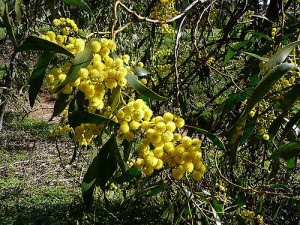
The golden wattle (Acacia pycnantha) is a member of the Fabaceae family. The plant is a small tree that can grow up to 12 meters high! In Australia the 1st September is National Wattle Day. Image by Sydney Oats used under Creative Commons 2.0.
The Australian national flower is the Acacia pycnantha, or wattle, first described in 1942. Its name comes from the Greek pyknos (dense) and anthos (flowers) describing the dense groups of flowers that form on the tree. The wattle is an important source of tannins, and as such has been introduced to parts of southern Europe such as Italy and Portugal in addition to India and New Zealand. The wattle is also found in South Africa where it has now become an invasive pest, and various methods of biological control such as gall forming wasps (Trichilogaster signiventris) are being used to control populations.
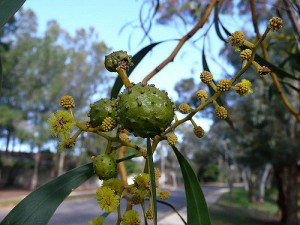
Galls on a wattle tree from T. signiventris. Eggs are laid by the wasp in the buds of flower heads and the hatched larvae induce gall formation which prevents flower development. This in turn prevents pollination and continued propagation of the Wattle population. Image by Sydney Oats used under Creative Commons 2.0.
Japan The Japanese Society of Plant Physiologists
Yellow Chrysanthemum
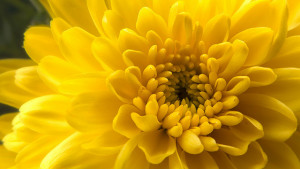
The yellow Chrysanthemum is a member of the Asteraceae family. Species of the Chrysanthemum enus are popular ornamental plants, and as such many hybrids and thousands of cultivars in a variety of colors and shapes can be found. Image by Joe deSousa used under Creative Commons 1.0.
Although cherry blossom is often the flower most associated with Japan, yellow Chrysanthemum flowers are equally as important. The flower is used as the Imperial Seal of Japan and on the cover of Japanese passports. Species of the genus Chrysanthemum are members of the Asteraceae (daisy) family.
Two species of the Chrysanthemum genus, C. cinerariifolium and C. coccineum, synthesize pyrethrum compounds, which attack insect nervous systems. As such these species make good companion plants in the field, repelling insects from economically valuable neighboring plants that do not have their own defense mechanisms. The naturally produced toxins are widely used in organic farming, and many synthetic versions are also available commercially.
South Africa African Crop Science Society
Protea cynaroides
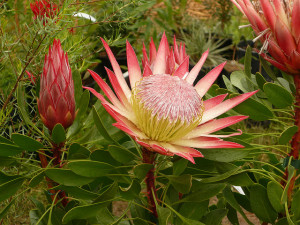
The king protea (Protea cynaroides) is a member of the Proteaceae family and the national flower of South Africa. The South African cricket team has the nickname the Proteas, after the flower. Image by Virginia Manso, used under Creative Commonds 2.0.
The king protea (Protea cynaroides) can grow up to 2 meters in height and comes in several colors and varieties. The plant grows in harsh, dry regions prone to wildfire, and as such has a number of adaptations for the environment. For example, a long tap-root is used for accessing deep water, and tough leathery leaves are resilient to both biotic and abiotic stress. The protea has a thick underground stem with many dormant buds. After a wildfire these dormant buds can become active, forming new stems allowing the plant to survive!
The king protea is only one species within the large Proteaceae family, 120 species of which are now endangered listed on the IUCN Red List of threatened species. The Protea Atlas Project aims to map the geographical location of proteas through Southern Africa in order to help preserve the family. In addition to protea, Southern Africa is home to around 24 000 plant taxa, 80% of which occur no where else in the world. A wider objective of the Protea Atlas Project is to map species-richness patterns in Southern Africa. The distribution of Protea plants within the region largely seems to match the species-richness patterns of other plant species, and therefore proteas are being used as surrogates for plant diversity. Find out more about the project and get involved here.
Germany and Estonia EUCARPIA, EPSO, FESPB, SPPS
Centaurea cyanus
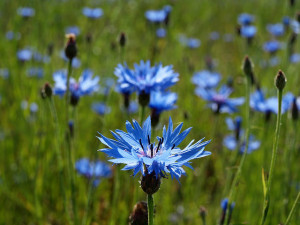
The cornflower (Centaurea cyanus) is a member of the Asteraceae family, like the Chrysanthemum. Image by Anita used under Creative Commons 2.0.
We have a large number of European and Scandinavian member groups, and choosing one flower to represent all of those was a challenge. However, the humble Cornflower seemed an appropriate choice to represent our European societies. This member of the daisy family is not only the national flower of Germany and Estonia, but has a place in many Scandinavian cultures being the symbol for a number of political parties in Finland and Sweden.
In the past this beautiful flower was regarded as a weed, but now due to intensive agricultural practices has become endangered. Cornflowers have many uses in addition to being an ornamental plant. The plant is used in many blends of herbal tea, flowers are edible in salads, and the blue coloring can be used as a clothes dye.
Canada Canadian Society of Plant Biologists
Acer
Although not technically a flower, the leaf of the maple tree is such an iconic symbol on the Canadian flag we just had to include it (we are the Global Plant Council after all). There are many species of maple tree in the genus Acer, which can be distinguished from other genus of trees by their distinctive leaf shape. The most important species of maple in Canada is probably Acer saccharum, the sugar maple. The sap of this species is the major source of maple syrup, and its hard wood is popular for use in flooring and furniture.

Acer saccharum, the sugar maple, in Autumn. Image by Mark K. used under Creative Commons 2.0.
The sugar maple grows throughout the USA and Canada, favoring cooler climates and is a very shade tolerant species. Despite this, the sugar maple is now in decline in many regions. It is highly susceptible to increased levels of air pollution and changes to salt levels. As such the species is now being replaced in many regions by the hardier Norway Maple.
Argentina Argentinian Society of Plant Physiology
Erythrina crista-galli
E. crista-galli, the cockspur coral tree, is the national tree in Argentina. Also known in Argentina as the ceibo, the bright red flower of this tree is also the national flower of Argentina and Uruguay.
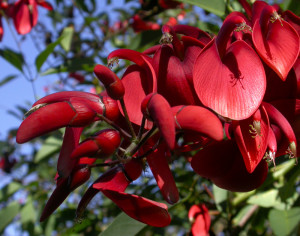
The bright red flowers of E.crista-galli are the national flowers of Argentina and Uruguay. Image by Gabriella F.Ruellan used under Creative Commons 2.0.
The small tree is a legume from the family Fabaceae. Characteristically of species from this family, the fruit of the cockspur coral tree are dry pods, and the roots have nodules containing nitrogen fixing bacteria making them important for increasing the available nitrogen in the soil. Although native to South America, the tree is also naturalized in Australia, where it is becoming an emerging environmental weed. The tree is invading waterways and wetlands displacing native species, and its spread is now being controlled in New South Wales.
If your country has a particularly interesting national flower that we have missed let us know! Perhaps we can include it in a future blog post.